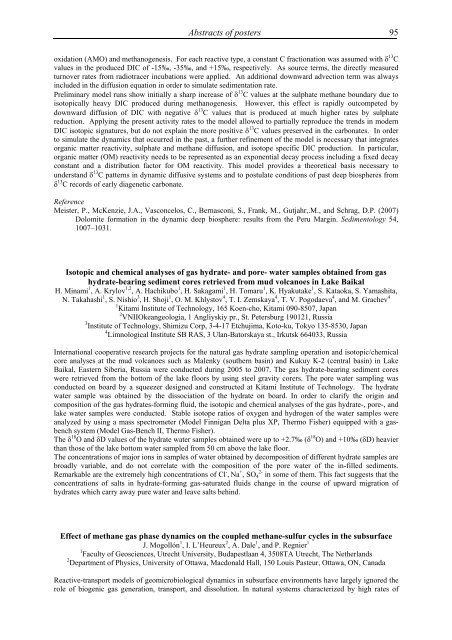Ninth international conference on - Marum
Ninth international conference on - Marum
Ninth international conference on - Marum
Create successful ePaper yourself
Turn your PDF publications into a flip-book with our unique Google optimized e-Paper software.
Abstracts of posters 95<br />
oxidati<strong>on</strong> (AMO) and methanogenesis. For each reactive type, a c<strong>on</strong>stant C fracti<strong>on</strong>ati<strong>on</strong> was assumed with δ 13 C<br />
values in the produced DIC of -15‰, -35‰, and +15‰, respectively. As source terms, the directly measured<br />
turnover rates from radiotracer incubati<strong>on</strong>s were applied. An additi<strong>on</strong>al downward advecti<strong>on</strong> term was always<br />
included in the diffusi<strong>on</strong> equati<strong>on</strong> in order to simulate sedimentati<strong>on</strong> rate.<br />
Preliminary model runs show initially a sharp increase of δ 13 C values at the sulphate methane boundary due to<br />
isotopically heavy DIC produced during methanogenesis. However, this effect is rapidly outcompeted by<br />
downward diffusi<strong>on</strong> of DIC with negative δ 13 C values that is produced at much higher rates by sulphate<br />
reducti<strong>on</strong>. Applying the present activity rates to the model allowed to partially reproduce the trends in modern<br />
DIC isotopic signatures, but do not explain the more positive δ 13 C values preserved in the carb<strong>on</strong>ates. In order<br />
to simulate the dynamics that occurred in the past, a further refinement of the model is necessary that integrates<br />
organic matter reactivity, sulphate and methane diffusi<strong>on</strong>, and isotope specific DIC producti<strong>on</strong>. In particular,<br />
organic matter (OM) reactivity needs to be represented as an exp<strong>on</strong>ential decay process including a fixed decay<br />
c<strong>on</strong>stant and a distributi<strong>on</strong> factor for OM reactivity. This model provides a theoretical basis necessary to<br />
understand δ 13 C patterns in dynamic diffusive systems and to postulate c<strong>on</strong>diti<strong>on</strong>s of past deep biospheres from<br />
δ 13 C records of early diagenetic carb<strong>on</strong>ate.<br />
Reference<br />
Meister, P., McKenzie, J.A., Vasc<strong>on</strong>celos, C., Bernasc<strong>on</strong>i, S., Frank, M., Gutjahr,.M., and Schrag, D.P. (2007)<br />
Dolomite formati<strong>on</strong> in the dynamic deep biosphere: results from the Peru Margin. Sedimentology 54,<br />
1007–1031.<br />
Isotopic and chemical analyses of gas hydrate- and pore- water samples obtained from gas<br />
hydrate-bearing sediment cores retrieved from mud volcanoes in Lake Baikal<br />
H. Minami 1 , A. Krylov 1,2 , A. Hachikubo 1 , H. Sakagami 1 , H. Tomaru 1 , K. Hyakutake 1 , S. Kataoka, S. Yamashita,<br />
N. Takahashi 1 , S. Nishio 3 , H. Shoji 1 , O. M. Khlystov 4 , T. I. Zemskaya 4 , T. V. Pogodaeva 4 , and M. Grachev 4<br />
1 Kitami Institute of Technology, 165 Koen-cho, Kitami 090-8507, Japan<br />
2 VNIIOkeangeologia, 1 Angliyskiy pr., St. Petersburg 190121, Russia<br />
3 Institute of Technology, Shimizu Corp, 3-4-17 Etchujima, Koto-ku, Tokyo 135-8530, Japan<br />
4 Limnological Institute SB RAS, 3 Ulan-Batorskaya st., Irkutsk 664033, Russia<br />
Internati<strong>on</strong>al cooperative research projects for the natural gas hydrate sampling operati<strong>on</strong> and isotopic/chemical<br />
core analyses at the mud volcanoes such as Malenky (southern basin) and Kukuy K-2 (central basin) in Lake<br />
Baikal, Eastern Siberia, Russia were c<strong>on</strong>ducted during 2005 to 2007. The gas hydrate-bearing sediment cores<br />
were retrieved from the bottom of the lake floors by using steel gravity corers. The pore water sampling was<br />
c<strong>on</strong>ducted <strong>on</strong> board by a squeezer designed and c<strong>on</strong>structed at Kitami Institute of Technology. The hydrate<br />
water sample was obtained by the dissociati<strong>on</strong> of the hydrate <strong>on</strong> board. In order to clarify the origin and<br />
compositi<strong>on</strong> of the gas hydrates-forming fluid, the isotopic and chemical analyses of the gas hydrate-, pore-, and<br />
lake water samples were c<strong>on</strong>ducted. Stable isotope ratios of oxygen and hydrogen of the water samples were<br />
analyzed by using a mass spectrometer (Model Finnigan Delta plus XP, Thermo Fisher) equipped with a gasbench<br />
system (Model Gas-Bench II, Thermo Fisher).<br />
The δ 18 O and δD values of the hydrate water samples obtained were up to +2.7‰ (δ 18 O) and +10‰ (δD) heavier<br />
than those of the lake bottom water sampled from 50 cm above the lake floor.<br />
The c<strong>on</strong>centrati<strong>on</strong>s of major i<strong>on</strong>s in samples of water obtained by decompositi<strong>on</strong> of different hydrate samples are<br />
broadly variable, and do not correlate with the compositi<strong>on</strong> of the pore water of the in-filled sediments.<br />
Remarkable are the extremely high c<strong>on</strong>centrati<strong>on</strong>s of Cl - , Na + , SO4 2- in some of them. This fact suggests that the<br />
c<strong>on</strong>centrati<strong>on</strong>s of salts in hydrate-forming gas-saturated fluids change in the course of upward migrati<strong>on</strong> of<br />
hydrates which carry away pure water and leave salts behind.<br />
Effect of methane gas phase dynamics <strong>on</strong> the coupled methane-sulfur cycles in the subsurface<br />
J. Mogollón 1 , I. L’Heureux 2 , A. Dale 1 , and P. Regnier 1<br />
1 Faculty of Geosciences, Utrecht University, Budapestlaan 4, 3508TA Utrecht, The Netherlands<br />
2 Department of Physics, University of Ottawa, Macd<strong>on</strong>ald Hall, 150 Louis Pasteur, Ottawa, ON, Canada<br />
Reactive-transport models of geomicrobiological dynamics in subsurface envir<strong>on</strong>ments have largely ignored the<br />
role of biogenic gas generati<strong>on</strong>, transport, and dissoluti<strong>on</strong>. In natural systems characterized by high rates of














